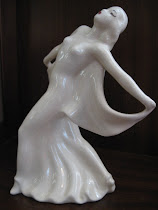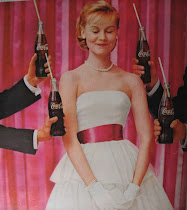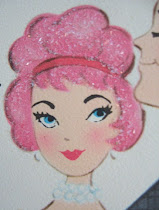I'll bet you didn't know that for a few months this past summer I was on the road to becoming the Queen of Vintage Catalogs.
This was the catalog that started things off: a Montgomery Ward - Spring and Summer 1943.
I have owned a few vintage catalogs for years - a Montgomery Ward's and a Butler Bros. from the 1920's and a J.C. Penney catalog from 1972, and had always enjoyed paging through them. But last June when I purchased my first 1940's catalog on Etsy - the 1943 oversized Ward's catalog pictured above - I was completely enchanted. What drew me in were the big and beautiful full-page color fashion photographs. They were breathtaking.
Montgomery Ward Catalog cover, 1949 Spring and Summer
Shortly after that first Etsy purchase, I was the winning eBay bidder on this lovely 1949 catalog. Again, stunning photographs - a number of them in color - and they were huge!
I've discovered that vintage Montgomery Ward catalogs, at least up through 1960, are all oversized catalogs measuring 13 1/4" x 9". Sears, Roebuck and Co. catalogs are wonderful too, but they've always been smaller - 11" x 8 1/4" - at least from the 1920's on.
Those first two catalogs got me hooked, and soon I was on Etsy and eBay constantly, hunting for good deals on vintage catalogs - and spending every bit of the money that I earned from selling on eBay as quickly as it came in. Sears Roebuck, Montgomery Ward... it didn't matter... I loved them all!
It didn't take long before I had added these seven catalogs from the 1940's to my collection. (l to r) Spring and Summer 1940; Spring and Summer 1943; Spring and Summer 1945; Fall and Winter 1945-46; Fall and Winter 1946-47; Spring and Summer 1948; Spring and Summer 1949. The two shorter catalogs in the top row are Sears Roebuck, and the rest are Montgomery Ward.
Do you think I stopped with the 1940's - no way! Next I started on the 1950's and the 1930's (those were tough to get for a decent price), and my next decade of focus was going to be the 1960's.
I was bidding on so many at once, I started to worry that I was going to end up with two of the same catalog. So I made an Excel chart to track, by year and season, which catalogs I already owned, and which were on the way in the mail.
I was definitely a woman on a mission!
I remember going out to a Chinese buffet with my son one evening, and during our meal I couldn't contain my excitement. "Daniel," I said, "I've decided that I want to own a copy of every single Montgomery Ward and Sears Catalog from 1920 to 1969! I want to be known as the Catalog Queen!"
He laughed at me, of course. Then we quickly figured out that if I ever reached my goal I'd have a staggering 200 catalogs in my collection. "Why would you want to do that?" he asked. "What's the point?"
What's the point?! Well, first of all, it would just be really cool to have a complete collection of those two famous catalog names - don't you think? I wonder if anyone's managed it? Yeah, probably. Maybe even one of you has come close?
Also, how fun it would be to have the resources at my fingertips to become an expert on vintage catalog fashion, and be able to answer important questions like:
1) When did the snood, the halter, the peep toe, the turban, the bolero, the circle skirt, the mini skirt, etc. first appear as a new fashion item in a Sears or Ward's catalog?
The snood is "fashion's newest whimsey" in the Sears catalog, Spring and Summer 1940.
2) Which company was the quickest to share the newest fashion trends - Sears or Ward's?
3) What distinguishes a Beret from a Pillbox from a Derby or a Cloche, a Toque, a Breton, a Bonnet, a Calot or Bumper hat?
4) When did wonder fabrics like Sharkskin and Lastex first appear - and then disappear?
Rayon Sharkskin dresses featured in Sears catalog, Spring/Summer 1940.
5) Year by year, what direction were hemlines and necklines, shoulders, sleeves and skirts going? - Were they going up or down? wider or narrower?
I'll never know the answers to all these questions because I never managed to get even close to reaching my goal of being the "Queen of Vintage Catalogs." After buying 21 catalogs in less than three months, I decided it was time to quit.
I finally took a break from my buying frenzy to add up what I'd spent on catalogs that summer - nearly $300 - yikes! There was no question that this rather expensive little addiction was one I simply couldn't afford. At the same time, I was also beginning to lose my enthusiasm because of information overload. It was clear that in order to have the time to do all the research necessary to truly become an expert on catalog fashion, I'd have to quit my day job - which was not an option!
Montgomery Ward Catalog cover, Fall and Winter 1945-46.
And so my dear readers, visions of being catalog royalty are no longer dancing around in my head.
I'm back to being just a common ordinary lover of vintage fashion who knows just enough to get by, to be a little dangerous, and to have some fun...
These days when I look at catalogs, I mostly just turn the pages and enjoy the pretty pictures - like these winter coats and suits from my 1945-46 Ward's catalog...
I've included the catalog descriptions for your reading pleasure, because I think that the words are just as lovely and intriguing as the fashion photographs.
Color-Gay Cardigan...Scrolled Braid Perked Pockets...Ebony Spiced Buttons... Those words sound good enough to eat, don't you think?
Have you noticed Ward's use of the word "revers" to describe the coat lapels? Coat "C" above, in the American Beauty color, has "Sweetheart Revers." That term wasn't used by Sears Roebuck. The same style of coat collar in my Sears 1945 catalog was referred to as having "Heart Lapels."
Here's a closer look at the hats worn by each of the models above.
Taking the photographs drew my attention to their makeup and hair too. Notice that each of the three models has pretty much the same hairstyle - parted on the side, pulled off the face with some sort of clip, and then curled under along the neckline, from the ear down to the shoulder.
In 1945-46, Ward's chose to have nearly every one of their featured models, who were sporting the newest fashion trends, wear their hair that same way. I wasn't seeing much that resembled a "Victory Roll" in this particular catalog - except on the more "mature" women. Were Victory Rolls becoming out of fashion by this point? Had that style reached its peak in the early 40's?
So, what do you suppose makes Hat A a "Bumper" rather than a "Beret" like Hat B? They seem to have similar styling and tilt. I just don't know...
I have lots of questions, but very few answers. See, I would have failed miserably as Queen!
So the position is still open. Anyone want to take a shot at it? :-)



































































.png)













































.png)




















































